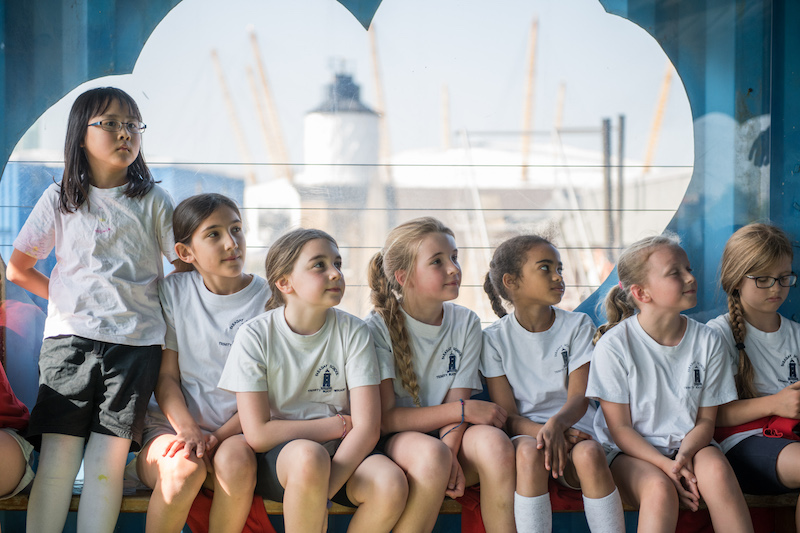Curiosity, Collaboration and the Arts
Posted on 13th Jun 2019 in School News, Which London School?

Claire Murdoch, Head of Faraday School in London, promotes a curriculum that inspires creativity and a love of learning...
“But still try, for who knows what is possible?”
Michael Faraday
For parents and teachers everywhere, hearts sink at the defeatist cry of ‘I can’t do this’ or ‘I’m stuck’.
At Faraday school we turn that fear on its head. We believe that terrifying moment – when a solution seems impossible and you just want to give up – shouldn’t be feared, but celebrated. The frontiers of your knowledge have met the march of your curiosity. And we are helping children to realise that THIS is the very moment where the challenge has been set, now it’s time to knuckle down and give it your best shot.
By encouraging curiosity, our pupils reach a tipping point, and that is when the real learning begins…
It was in our quest to develop resilience and a growth mindset amongst the pupils that we have recognised how important our investment in the arts and our close relationship with the wonderful local community has been. At Faraday, we find ourselves settled in a uniquely creative and inspirational environment at Trinity Buoy Wharf, East London surrounded by small businesses, entrepreneurs and artists, who have come together to form a burgeoning environment for the arts. The school has used its location as a springboard for its own development, knowing that risk-taking and being willing to fail is something that resonates particularly strongly in all creative endeavours.
The renowned physicist, Michael Faraday worked in an experimental lighthouse next door to our school for many years and some of his most exciting ideas were conjured up in his workshop overlooking the river Lea. As the figurehead of Faraday, we have absorbed some of his key characteristics of perseverance, persistence and determination into the heart of our school. We know that much of Faraday’s early success was based upon his making the most of every opportunity, secretly reading the books that he was binding as an apprentice and developing a love of science that saw him sneak into the back of lecture theatres to increase his understanding. He had an intense appetite for experimenting, spending hours trying out new methods and techniques before settling upon his theory, and it is this inquisitiveness and ingenuity that continues to inspire our students as they hope to live up to his legacy.
Science and the arts are for us the umbrella within which we can explore curiosity, enquiry and a curriculum that inspires children to keep on learning. When many schools around us are being forced to reduce the opportunities they can offer in these subjects, due to funding or curriculum restraints, we feel it is ever more important to offer an all-round education that really develops the creative side of learning. There is an abundance of evidence that shows the value of nurturing curiosity, creativity and collaboration and these three Cs are a key part of our mantra at Faraday. These key skills are not tied to specific subjects but can be seen across the curriculum wherever children are given opportunities to create, compose and use their imagination to problem-solve or explore alternative solutions where they thought there were none. One of the clear benefits from this approach has been how pupil well-being has been positively impacted and an individual’s ability to traverse more difficult paths has increased through carefully designed artistic endeavours. From our initial projects, we have already begun to see how important these occasions can be for young people.
One of the achievements of which we are most proud has been the introduction of a new school newspaper the Trinity Times, due to print its first run in April 2019, with school reporters seen out about on the Wharf interviewing local residents and selling their new rag in the local café. Their articles have documented our achievements, featuring the collaborative artwork that the children exhibited locally and all the artists, scientists and sculptors that have been rallied to collaborate on installations and workshops in school, helping the pupils develop their ideas and show their work. Ultimately, our engagement with the local community has shown us that we are valued and opened our eyes to all the many organisations and volunteers who want to be involved in the education of our children.
Just as we are asking our children to do, it is vital that we are open and innovative in approach taking risks and trying new things. We have found evidence of all sorts of progress with our approach and this has allowed us to hone our curriculum by remaining flexible and reactive to the pupils’ interests. Faraday, as part of the New Model Schools Company, has a not-for-profit ethos and a sustainable philosophy that hopes to enable as many children as possible to be able to access a broad, rigorous and exciting education at the lowest sustainable cost. By maintaining links with the community, inspiring our teachers and utilising the huge talent and experience within our staff, we can ensure that those at Faraday receive an invigorating and enriching education, rooted in knowledge but with no limits as to how it is developed or responded to by the pupils.
You have to be brave to open your doors to others but the opportunities you may find there will always make this step worthwhile. We look forward to what we can achieve at Faraday in the coming years, knowing that we have the full support of those around us.
This article first appeared in Which London School? & the South-East 2019/20, which can be read below: